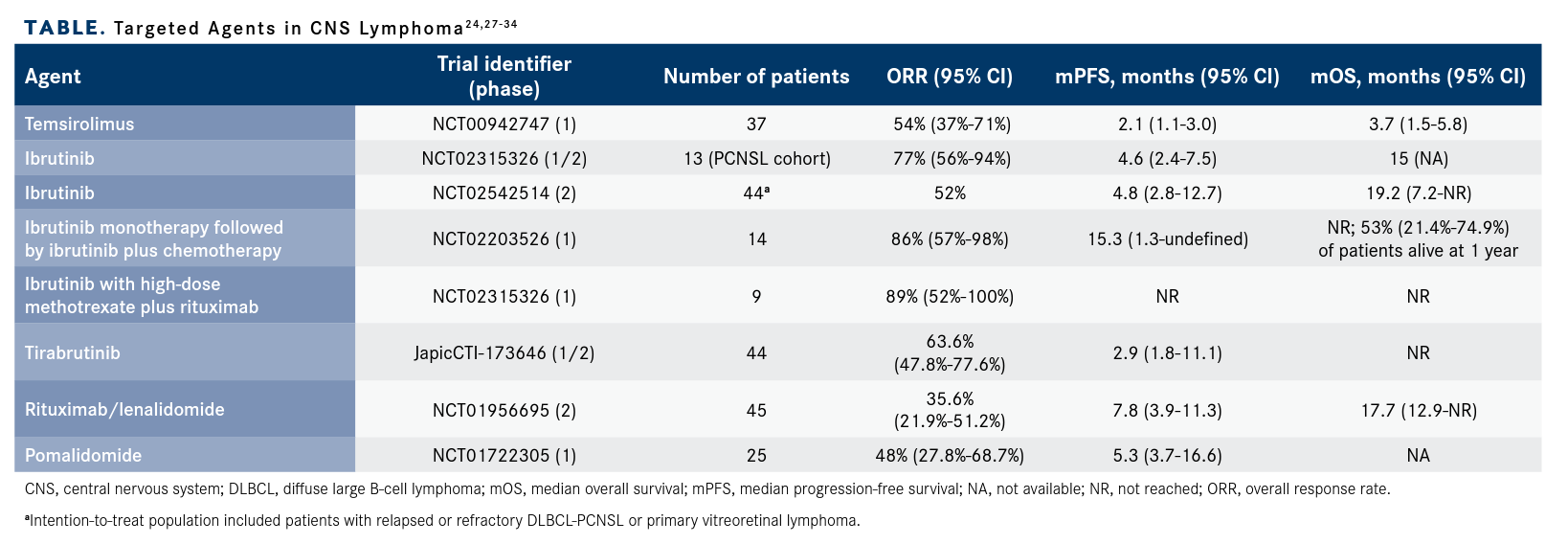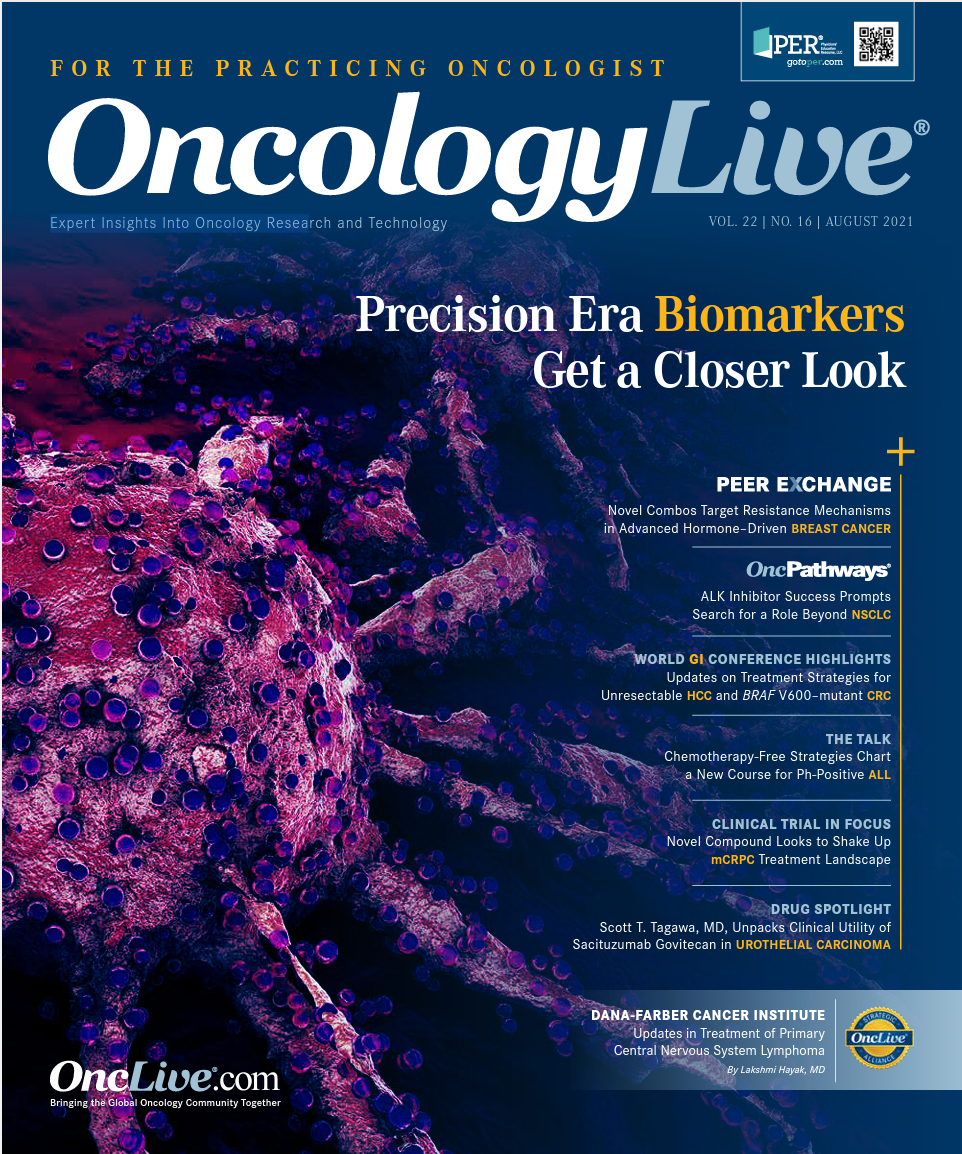Publication
Article
Oncology Live®
Future of Care for PCNSL Relies on Adapting Personalized Approaches
Author(s):
Primary central nervous system lymphoma is a rare and aggressive variant of extranodal non-Hodgkin lymphoma that occurs in the brain, spinal cord, cerebrospinal fluid, or eyes in the absence of systemic disease.
Lakshmi Nayak, MD

Primary central nervous system lymphoma (PCNSL) is a rare and aggressive variant of extranodal non-Hodgkin lymphoma (NHL) that occurs in the brain, spinal cord, cerebrospinal fluid (CSF), or eyes in the absence of systemic disease. Although it responds favorably to chemotherapy and radiation, prognosis is inferior to that of other subtypes of NHL. PCNSL accounts for 3% of all brain tumors and 6% of all extranodal lymphomas, and approximately 90% of cases are classified as diffuse large B-cell lymphomas (DLBCLs), with T-cell lymphoma, low-grade lymphoma, and Burkitt lymphoma accounting for the remaining 10%.1
Histopathology reveals malignant B cells in an angiocentric pattern with diffuse infiltration of the central nervous system (CNS), indistinguishable from systemic DLBCL, and gene-expression profiling demonstrates that the majority of PCNSLs are of the nongerminal center or activated B-cell–like (ABC) subtype.2 Age and performance status have been identified as independent predictors associated with prognosis.3,4 An early diagnosis by brain biopsy is preferable, followed by an evaluation of the extent of disease for staging and rapid institution of treatment; these are paramount to achieve neurologic recovery and improve survival.5
Management of newly diagnosed PCNSL has evolved over the past several years and standard-of-care guidelines are based on data from both single-arm and randomized phase 2/3 trials. In general, high-dose methotrexate (HD-MTX) in combination with an alkylating agent, such as high-dose cytarabine and rituximab (Rituxan), is recommended for induction therapy, although the role of rituximab, particularly in elderly patients, is the focus of debate because of conflicting trial results.6-9 The majority of HD-MTX–based chemotherapy regimens have demonstrated complete response rates of 50% and overall response rates of up to 90%. Intrathecal chemotherapy is not utilized based on data from prior studies and only offered to patients with an insufficient CSF response to HD-MTX or to those who are unable to receive HD-MTX at a dose of at least 3 g/m2, which is required for adequate CSF penetration.
It is unclear whether patients with ocular involvement would benefit from the addition of local therapy in the form of intravitreal MTX or ocular radiation to systemic chemotherapy. Typically, local therapy is considered if systemic therapy fails to achieve ocular disease control or if there is ocular recurrence. Consolidation therapy is recommended after completion of induction in appropriate patients to improve long-term disease-free survival. Whole-brain radiation therapy (WBRT) has historically been used for consolidation; however, there is increasing evidence that WBRT results in delayed and irreversible neurocognitive impairment in patients who are 60 years or older, particularly when delivered in combination with HD-MTX.10 Given that the median age when receiving a diagnosis is 65 years, this approach is no longer preferred as first-line treatment and is reserved for salvage. Reduced-dose WBRT is under investigation in a randomized clinical trial.
Determining the Right Treatment Regimen
Although there is a progression-free survival (PFS) benefit, the impact on long-term neurotoxicity remains to be seen.11 Over the past 10 years, long-term results of studies with high-dose chemotherapy followed by autologous stem cell transplant (HDC-ASCT) have demonstrated encouraging long-term PFS and overall survival (OS). Five-year PFS and OS rates of 81% to 83% have been reported specifically with thiotepa-based conditioning regimens, which are recommended over other conditioning regimens such as BEAM (carmustine, etoposide, cytarabine, and melphalan) or CBV (cyclophosphamide, carmustine, and etoposide), which have led to inferior outcomes.12-14
Data from 2 European, multicenter, randomized studies (NCT01011920, NCT00863460) comparing WBRT and HDC-ASCT for consolidation have shown similar efficacy or slight improvement of outcomes on the ASCT arm.15,16 Importantly, both studies note improvement of neurocognitive function with ASCT and worsening with WBRT. However, many studies investigating the role of HDC-ASCT have included younger, healthier patients. Additionally, the treatment-associated mortality with ASCT has been variable, ranging from 0% to 14%. Although this approach remains attractive, it requires careful patient selection and treatment at a specialized center. Overall, fewer than 10% to 15% of patients are candidates for such therapy.17
Nonmyeloablative chemotherapy regimens are also being considered for consolidation as an alternative to ASCT. Initial studies with high-dose etoposide and cytarabine (EA) have demonstrated encouraging results.18 Recent results from a randomized phase 2 study (NCT01511562), which compared EA with HDC-ASCT after induction plus MTR-A (HD-MTX, temozolomide [Temodar], rituximab, cytarabine) and was conducted by Alliance for Clinical Trials in Oncology, demonstrated superior PFS with ASCT; however, there was a notable difference in progressors (28% vs 11%, respectively; P = .05) during induction, which was the same treatment on both arms.19 There was no significant difference in OS.
Overcoming Roadblocks for the Elderly Population
The improvement of treatment regimens for PCNSL has resulted in doubling of outcomes in patients over the past 2 decades, although survival in elderly patients has not changed since the 1970s.20 This is likely multifactorial. Older age has shown to be an independently adverse prognostic factor, regardless of treat-ment, and these patients, who account for a significant number of patients with PCNSL, typically have multiple comorbidities and cannot tolerate the aggressive regimens previously described.
Recent data from tertiary care institu-tions and experienced groups have shown that HD-MTX regimens can be delivered safely in elderly patients and can lead to clin-ically meaningful outcomes.21 In patients who are unable to safely tolerate and clear HD-MTX due to tentative renal function, such as many older patients, glucarpidase can be used to cleave MTX into nontoxic metab-olites eliminated by the liver.22 There are ongoing clinical trials in several cancers, including PCNSL, to determine if glucarpi-dase can be used to safely deliver HD-MTX as an outpatient therapy to eliminate the long hospital stays required for continuous intra-venous hydration. Consolidation options in older patients are currently lacking.
Biomarkers Could Be the Future of Care
Up to one-third of patients with PCNSL are refractory to first-line therapy, and approx-imately 50% have a recurrence in the first 2 years.23 The management of relapsed or refrac-tory disease is challenging because of limited treatment options and factors such as age and further neurologic impairment. Recent insights into the pathophysiology of PCNSL have led to its recognition as a biologically distinct disease with targetable alterations and mutations.
B-cell receptor (BCR) has been identified as a key signaling pathway in PCNSL. Frequent genetic alterations of NF-κB and compo-nents of the toll-like receptor (TLR), such as MYD88 and the proximal BCR such as CD79B, are seen in PCNSL in higher percentages (> 70%-89%) compared with the ABC subtype of systemic DLBCL.24,25 Deletions or mutations in TNFAIP3 associated with chromosome 6q loss have been noted, as have chromosome 18q gains with high BCL2 expression. Copy number amplifications at chromosome 9p24.1 associated with PD-L1/PD-L2 expression have been described, which may imply a role in immune evasion in PCNSL. These and other observations have led to several phase 1 and 2 clinical trials with novel targeted agents as well as immunotherapies (TABLE24,27-34).
TABLE. Targeted Agents in CNS Lymphoma24,27-34

Various Bruton tyrosine kinase (BTK) inhibitors, immunomodulatory drugs, checkpoint inhibitors, mTOR/PI3K inhibi-tors, and BCL2 inhibitors are being studied as monotherapies or in combination.26 The BTK inhibitor ibrutinib (Imbruvica) and the immunomodulatory drug lenalidomide (Revlimid) are included in the National Comprehensive Cancer Network guidelines as considerations for relapsed or refractory PCNSL based on the evidence of activ-ity.35 Although the responses with these agents are high—50% to 60%—the durability of the responses is under 6 months. CD19-directed chimeric antigen receptor T-cell therapy, which has shown remarkable activ-ity and long-term remission in relapsed or refractory systemic DLBCL, is being investi-gated in PCNSL.
The precise role of novel agents in PCNSL, including combinations and their introduc-tion in first-line treatment, is also under investigation. The agents hold tremendous promise for improving response rates and overall outcomes. Ongoing studies to enhance the knowledge of the unique biology of PCNSL—particularly mechanisms of resis-tance, role of circulating tumor DNA in CSF in defining minimal residual disease and its relevance to recurrence, and identification of predictive biomarkers—will be critical to designing effective therapeutic options.
References
- Ostrom QT, Cioffi G, Gittleman H, et al. CBTRUS statistical report: primary brain and other central nervous system tumors diagnosed in the United States in 2012-2016. Neuro Oncol. 2019;21(suppl 5):v1-v100. doi:10.1093/neuonc/noz150
- Camilleri-Broët S, Crinière E, Broët P, et al. A uniform activated B-cell-like immunophenotype might explain the poor prognosis of primary central nervous system lymphomas: analysis of 83 cases. Blood. 2006;107(1):190-196. doi:10.1182/blood-2005-03-1024
- Abrey LE, Ben-Porat L, Panageas KS, et al. Primary central nervous system lymphoma: the Memorial Sloan-Kettering Cancer Center prognostic model. J Clin Oncol. 2006;24(36):5711-5715. doi:10.1200/jco.2006.08.2941
- Ferreri AJM, Blay JY, Reni M, et al. Prognostic scoring system for primary CNS lymphomas: the International Extranodal Lymphoma Study Group experience. J Clin Oncol. 2003;21(2):266-272. doi:10.1200/jco.2003.09.139
- Abrey LE, Batchelor TT, Ferreri AJM, et al. Report of an international workshop to standardize baseline evaluation and response criteria for primary CNS lymphoma. J Clin Oncol. 2005;23(22):5034-5043. doi:10.1200/jco.2005.13.524
- Bromberg JEC, Issa S, Bakunina K, et al. Rituximab in patients with primary CNS lymphoma (HOVON 105/ALLG NHL 24): a randomised, open-label, phase 3 intergroup study. Lancet Oncol. 2019;20(2):216-228. doi:10.1016/S1470-2045(18)30747-2
- Ferreri AJM, Cwynarski K, Pulczynski E, et al. Chemoimmunotherapy with methotrexate, cytarabine, thiotepa, and rituximab (MATRix regimen) in patients with primary CNS lymphoma: results of the first randomisation of the International Extranodal Lymphoma Study Group-32 (IELSG32) phase 2 trial. Lancet Haematol. 2016;3(5):e217-e227. doi:10.1016/S2352-3026(16)00036-3
- Chukwueke UN, Nayak L. Central nervous system lymphoma. Hematol Oncol Clin North Am. 2019;33(4):597-611. doi:10.1016/j.hoc.2019.03.008
- Citterio G, Reni M, Gatta G, Ferreri AJM. Primary central nervous system lymphoma. Crit Rev Oncol Hematol. 2017;113:97-110. doi:10.1016/j.critrevonc.2017.03.019
- Correa DD, Shi W, Abrey LE, et al. Cognitive functions in primary CNS lymphoma after single or combined modality regimens. Neuro Oncol. 2012;14(1):101-108. doi:10.1093/neuonc/nor186
- Omuro A, DeAngelis LM, Karrison T, et al. Randomized phase II study of rituximab, methotrexate (MTX), procarbazine, vincristine, and cytarabine (R-MPV-A) with and without low-dose whole-brain radiotherapy (LD-WBRT) for newly diagnosed primary CNS lymphoma (PCNSL). J Clin Oncol. 2020;38(suppl 15):2501. doi:10.1200/JCO.2020.38.15_suppl.2501
- Omuro A, Correa DD, DeAngelis LM, et al. R-MPV followed by high-dose chemotherapy with TBC and autologous stem-cell transplant for newly diagnosed primary CNS lymphoma. Blood. 2015;125(9):1403-1410. doi:10.1182/blood-2014-10-604561
- Illerhaus G, Kasenda B, Ihorst G, et al. High-dose chemotherapy with autologous haemopoietic stem cell transplantation for newly diagnosed primary CNS lymphoma: a prospective, single-arm, phase 2 trial. Lancet Haematol. 2016;3(8):e388-e397. doi:10.1016/S2352-3026(16)30050-3
- Abrey LE, Moskowitz CH, Mason WP, et al. Intensive methotrexate and cytarabine followed by high-dose chemotherapy with autologous stem-cell rescue in patients with newly diagnosed primary CNS lymphoma: an intent-to-treat analysis. J Clin Oncol. 2003;21(22):4151-4156. doi:10.1200/jco.2003.05.024
- Ferreri AJM, Cwynarski K, Pulczynski E, et al. Whole-brain radiotherapy or autologous stem-cell transplantation as consolidation strategies after high-dose methotrexate-based chemoimmunotherapy in patients with primary CNS lymphoma: results of the second randomisation of the International ExtranodalLymphoma Study Group-32 phase 2 trial. Lancet Haematol. 2017;4(11):e510-e523. doi:10.1016/S2352-3026(17)30174-6
- Houillier C, Taillandier L, Dureau S, et al. Radiotherapy or autologous stem-cell transplantation for primary CNS lymphoma in patients 60 years of age and younger: results of the intergroup ANOCEF-GOELAMS randomized phase II PRECIS study. J Clin Oncol. 2019;37(10):823-833. doi:10.1200/jco.18.00306
- Houillier C, Soussain C, Ghesquières H, et al. Management and outcome of primary CNS lymphoma in the modern era: an LOC network study. Neurology. 2020;94(10):e1027-e1039. doi:10.1212/wnl.0000000000008900
- Rubenstein JL, Hsi ED, Johnson JL, et al. Intensive chemotherapy and immunotherapy in patients with newly diagnosed primary CNS lymphoma: CALGB 50202 (Alliance 50202). J Clin Oncol. 2013;31(25):3061-3068. doi:10.1200/jco.2012.46.9957
- Batchelor T, Giri S, Ruppert AS, et al. Myeloablative versus non-myeloablative consolidative chemotherapy for newly diagnosed primary central nervous system lymphoma: results of CALGB 51101 (Alliance). J Clin Oncol. 2021;39(15):7506. doi:10.1200/jco.2021.39.15_suppl.7506
- Mendez JS, Ostrom QT, Gittleman H, et al. The elderly left behind-changes in survival trends of primary central nervous system lymphoma over the past 4 decades. Neuro Oncol. 2018;20(5):687-694. doi:10.1093/neuonc/nox187
- Kasenda B, Ferreri AJM, Marturano E, et al. First-line treatment and outcome of elderly patients with primary central nervous system lymphoma (PCNSL)--a systematic review and individual patient data meta-analysis. Ann Oncol. 2015;26(7):1305-1313. doi:10.1093/annonc/mdv076
- Ramsey LB, Balis FM, O’Brien MM, et al. Consensus guideline for use of glucarpidase in patients with high-dose methotrexate induced acute kidney injury and delayed methotrexate clearance. Oncologist. 2018;23(1):52-61. doi:10.1634/theoncologist.2017-0243
- Langner-Lemercier S, Houillier C, Soussain C, et al. Primary CNS lymphoma at first relapse/progression: characteristics, management, and outcome of 256 patients from the French LOC network. Neuro Oncol. 2016;18(9):1297-1303. doi:10.1093/neuonc/now033
- Grommes C, Pastore A, Palaskas N, et al. Ibrutinib unmasks critical role of Bruton tyrosine kinase in primary CNS lymphoma. Cancer Discov. 2017;7(9):1018-1029. doi:10.1158/2159-8290.cd-17-0613
- Chapuy B, Roemer MGM, Stewart C, et al. Targetable genetic features of primary testicular and primary central nervous system lymphomas. Blood. 2016;127(7):869-881. doi:10.1182/blood-2015-10-673236
- Grommes C, Nayak L, Tun HW, Batchelor TT. Introduction of novel agents in the treatment of primary CNS lymphoma. Neuro Oncol. 2019;21(3):306-313. doi:10.1093/neuonc/noy193
- Korfel A, Schlegel U, Herrlinger U, et al. Phase II trial of temsirolimus for relapsed/refractory primary CNS lymphoma. J Clin Oncol. 2016;34(15):1757-1763. doi:10.1200/jco.2015.64.9897
- Soussain C, Choquet S, Blonski M, et al. Ibrutinib monotherapy for relapse or refractory primary CNS lymphoma and primary vitreoretinal lymphoma: final analysis of the phase II ‘proof-of-concept’ iLOC study by the lymphoma study association (LYSA) and the French oculo-cerebral lymphoma (LOC) network. Eur J Cancer. 2019;117:121-130. doi:10.1016/j.ejca.2019.05.024
- Lionakis MS, Dunleavy K, Roschewski M, et al. Inhibition of B cell receptor signaling by ibrutinib in primary CNS lymphoma. Cancer Cell. 2017;31(6):833-843. doi:10.1016/j.ccell.2017.04.012
- Grommes C, Tang SS, Wolfe J, et al. Phase 1b trial of an ibrutinib-based combination therapy in recurrent/refractory CNS lymphoma. Blood. 2019;133(5):436-445. doi:10.1182/blood-2018-09-875732
- Narita Y, Nagane M, Mishima K, et al. Phase I/II study of tirabrutinib, a second-generation Bruton’s tyrosine kinase inhibitor, in relapsed/refractory primary central nervous system lymphoma. Neuro Oncol. 2021;23(1):122-133. doi:10.1093/neuonc/noaa145
- Rubenstein JL, Geng H, Fraser EJ, et al. Phase 1 investigation of lenalidomide/rituximab plus outcomes of lenalidomide maintenance in relapsed CNS lymphoma. Blood Adv. 2018;2(13):1595-1607. doi:10.1182/bloodadvances.2017014845
- Ghesquieres H, Chevrier M, Laadhari M, et al. Lenalidomide in combination with intravenous rituximab (REVRI) in relapsed/refractory primary CNS lymphoma or primary intraocular lymphoma: a multicenter prospective ‘proof of concept’ phase II study of the French Oculo-Cerebral lymphoma (LOC) Network and the Lymphoma Study Association (LYSA). Ann Oncol. 2019;30(4):621-628. doi:10.1093/annonc/mdz032
- Tun HW, Johnston PB, DeAngelis LM, et al. Phase 1 study of pomalidomide and dexamethasone for relapsed/refractory primary CNS or vitreoretinal lymphoma. Blood. 2018;132(21):2240-2248. doi:10.1182/blood-2018-02-835496
- Holdhoff M, Mrugala MM, Grommes C, et al. Challenges in the treatment of newly diagnosed and recurrent primary central nervous system lymphoma. J Natl Compr Canc Netw. 2020;18(11):1571-1578. doi:10.6004/jnccn.2020.7667























%20(2)%201-Recovered-Recovered-Recovered-Recovered-Recovered-Recovered-Recovered-Recovered-Recovered-Recovered-Recovered-Recovered-Recovered-Recovered-Recovered-Recovered-Recovered.jpg?fit=crop&auto=format)
%20(2)%201-Recovered-Recovered-Recovered-Recovered-Recovered-Recovered-Recovered-Recovered-Recovered-Recovered-Recovered-Recovered-Recovered-Recovered-Recovered-Recovered-Recovered.jpg?fit=crop&auto=format)
